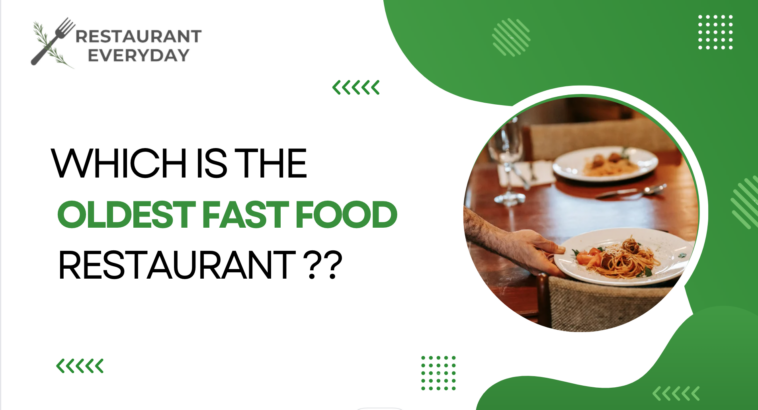Unveiling the Origins: Which is the oldest fast food restaurant
The term “fast food” can be interpreted differently, and the concept of selling ready-to-eat food quickly has been around for centuries. However, if we’re talking about the modern fast food industry that emerged in the 20th century, White Castle is often considered one of the oldest fast food chains.
Exploring Historical Milestones: Origins of Fast Food Chains
Billy Ingram and Walter Anderson founded White Castle in 1921 in Wichita, Kansas. They standardized food production in a way that allowed them to sell inexpensive sliders (small hamburgers) quickly. White Castle is often credited with popularizing the modern fast food business model, including the use of a drive-through and the emphasis on speed and efficiency.
It’s worth noting that while White Castle is one of the oldest fast food chains, there were earlier establishments that could be considered precursors to the fast food concept. For example, Automats, popular in the early 20th century, allowed customers to insert coins into machines to access pre-prepared food dishes.
Introduction: The Rise of Fast Food
The rise of fast food represents a transformative shift in how people consume and experience food. With roots extending over a century, the phenomenon has evolved from modest beginnings to a global culinary and cultural force. This introduction explores the historical trajectory, key players, and societal impacts that characterize the ascent of fast food.
Pioneers of Quick-Service Dining: Early Fast Food Innovators
The concept of quick and readily available food has deep historical roots, with early precursors including markets, inns, and food stands. However, it was in the 20th century that a more systematic and industrialized approach to fast food emerged. White Castle, founded in 1921, is often acknowledged as one of the pioneering establishments that introduced the concept of standardized production and affordable, on-the-go meals.
Evolutionary Journey: From Automats to Drive-Ins – The Birth of Fast Food
The post-World War II era witnessed a surge in the growth of fast food chains. Companies like McDonald’s, founded in 1940, revolutionized the industry by implementing assembly-line production techniques. This ensured consistency in taste and quality and facilitated rapid service, catering to an increasingly fast-paced lifestyle.
Cultural Influence and Globalization: Which is the oldest fast food restaurant?
As transportation and communication networks expanded, fast food chains transcended national borders, becoming symbols of globalization. American brands like McDonald’s, KFC, and Burger King spread across continents, influencing culinary preferences and creating a shared global culture around fast food.
The rise of fast food has profoundly affected various aspects of society. Changes in eating habits, nutritional concerns, and the acceleration of the fast-paced lifestyle are among the social transformations associated with the prevalence of fast food. Critics point to health issues related to high-calorie diets, while proponents celebrate the convenience and accessibility that fast food offers.
Diversification and Innovation in Fast Food Industry
Over the years, the fast food industry has continually adapted and innovated to meet changing consumer demands. Menu diversification, healthier options, and technological advancements, such as drive-throughs and mobile ordering, have played pivotal roles in sustaining the industry’s growth.
Fast Food’s Future: Trends, Challenges, and Adaptations
As the 21st century unfolds, the fast food landscape continues to evolve. Sustainability, ethical sourcing, and health-conscious choices have become focal points, challenging the industry to respond to changing consumer preferences.
The rise of local, artisanal alternatives also poses competition to traditional fast food giants, emphasizing the dynamic nature of the culinary landscape.
In this series, we will delve deeper into the historical milestones, business strategies, cultural influences, and societal implications that define the rise of fast food. Through this exploration, we aim to paint a comprehensive picture of an industry that has left an indelible mark on how we eat, socialize, and perceive food.
Oldest Contenders: Exploring the Candidates
In the quest to identify the oldest fast food restaurant, several contenders emerge, each with a unique history and contribution to the evolution of the fast food industry. Let’s explore some of these early pioneers who played crucial roles in shaping the landscape of quick-service dining:
Automats – Horn & Hardart (United States):
Overview: The Automat, operated by Horn & Hardart, was a groundbreaking concept that gained popularity in the early 20th century. It was a cafeteria with vending machines where customers could insert coins to access pre-prepared food dishes behind glass windows.
Significance: Horn & Hardart Automats, which first appeared in Philadelphia in 1902, revolutionized the dining experience by combining speed, affordability, and self-service. They were prevalent in major U.S. cities and continued to operate until the mid-20th century.
A&W (United States):
Overview: A&W, established in 1919 by Roy W. Allen and Frank Wright, is renowned for being one of the earliest and most successful fast-food franchises. It initially gained popularity for its root beer stands before expanding its menu to include hot dogs and hamburgers.
Significance: A&W played a crucial role in popularizing the franchise model and introducing the concept of drive-in restaurants. The brand’s iconic root beer floats and emphasis on a car-friendly dining experience contributed to its success.
White Castle (United States):
Overview: Founded in 1921 by Billy Ingram and Walter Anderson, White Castle is often considered one of the first fast food chains in the United States. It focused on selling small, affordable sliders in a clean and efficient environment.
Significance: White Castle is credited with standardizing food production and pioneering the modern fast-food business model. Its emphasis on cleanliness, consistency, and speed set the stage for the industry’s growth.
A Notable Mention: Automats in Europe:
While the Automat concept was popularized in the United States, similar automated dining establishments existed in Europe during the same period. For example, Quisisana Automats in Berlin, Germany, introduced the idea of self-service food dispensers in the early 20th century.
Conclusion:
Determining the absolute “oldest” fast food restaurant can be challenging due to the evolving nature of the industry and the diverse forms of quick-service dining that have emerged. The contenders mentioned here, whether Automats, A&W, or White Castle, played pivotal roles in shaping the fast food landscape, contributing to the industry’s rise and setting precedents for future developments.
Evolution of Fast Food: Impact on Society
The evolution of fast food has profoundly impacted society, influencing various aspects of culture, lifestyle, and health. Here are key points that highlight the societal effects of the fast food phenomenon:
1. Changing Eating Habits:
– Speed and Convenience: Fast food introduced the concept of quick-service dining, catering to the demands of a fast-paced lifestyle. It shifted eating habits from traditional, sit-down meals to on-the-go consumption.
– 24/7 Accessibility: Many fast food chains operate around the clock, providing Accessibility and convenience for people with non-traditional work hours or busy schedules.
2. Globalization of Culinary Tastes:
– Cultural Homogenization: Global fast food chains, particularly those originating in the United States, have become cultural ambassadors, influencing culinary preferences worldwide and contributing to a certain level of cultural homogenization.
– Localization Efforts: While maintaining global branding, fast food chains often adapt their menus to local tastes, balancing standardization and cultural sensitivity.
3. Health Concerns and Nutrition:
– Obesity Epidemic: The rise of fast food has been linked to an increase in obesity rates, particularly in countries where these establishments are prevalent. High-calorie, high-fat, and high-sugar offerings contribute to health concerns.
– Menu Diversification: Responding to health trends, many fast food chains have introduced healthier options, emphasizing salads, grilled items, and reduced-calorie alternatives.
4. Economic and Employment Impact:
– Job Creation: The fast food industry is a significant source of employment, providing jobs for millions worldwide, ranging from entry-level to managerial roles.
– Labor Practices: The industry has faced scrutiny for labour practices, including concerns about low wages and limited benefits for frontline workers.
5. Influence on Advertising and Marketing:
– Branding and Advertising: fast food chains are often at the forefront of innovative marketing and advertising campaigns, shaping consumer behaviour and influencing perceptions of food.
– Impact on Children: Marketing to children has raised ethical concerns, as fast food companies strategically target younger demographics.
6. Environmental Concerns:
– Packaging and Waste: The fast food industry’s reliance on disposable packaging contributes to environmental issues, including plastic waste. Efforts to address sustainability have led to changes in packaging materials and practices.
7. Social Spaces and Community Impact:
– Social Gathering Spaces: fast food establishments often serve as informal gathering places, contributing to the social fabric of communities.
– Community Engagement: Some fast food chains engage in philanthropy and community initiatives, aiming to impact the areas where they operate positively.
8. Technological Integration:
– Digital Ordering and Delivery: Technology integration, such as mobile apps and online ordering, has transformed how people interact with fast food establishments, providing added convenience.
The evolution of fast food is a complex interplay of cultural, economic, and technological factors, and its impact on society continues to evolve as the industry adapts to changing consumer preferences and societal expectations.
Also Read: Top 10 Italian Restaurants in Los Angeles
Conclusion: Unveiling the Oldest Fast Food Restaurant
In the quest to unveil the oldest fast food restaurant, our exploration has led us through a tapestry of historical milestones, innovative concepts, and pioneering establishments. While contenders such as Automats, A&W, and White Castle have each left an indelible mark on fast food’s evolution, the absolute oldest’s determination remains a nuanced challenge.
The Automats, with their revolutionary self-service concept, set the stage for the fast-paced, on-the-go dining experience in the early 20th century. A&W, born in 1919, introduced the franchise model and embraced the drive-in concept, changing how customers interacted with fast food. White Castle, a key player in forming the modern fast food business model since 1921, emphasized standardized production and affordability.
Yet, amidst these contenders, the definition of “fast food” and the various forms it has taken over the years make it challenging to pinpoint a singular origin. Early precursors, like Automats in Europe, contribute to the rich tapestry of quick-service dining woven over the decades.
Ultimately, fast food represents a dynamic and ever-evolving phenomenon transcending specific establishments. It embodies a cultural shift in how society approaches dining—a dress characterized by speed, convenience, and, at times, controversy.
As the fast food industry continues to adapt to changing tastes, health concerns, and global influences, the legacy of these pioneering establishments endures, shaping the present and future of how we eat, live, and connect in a fast-paced world.




